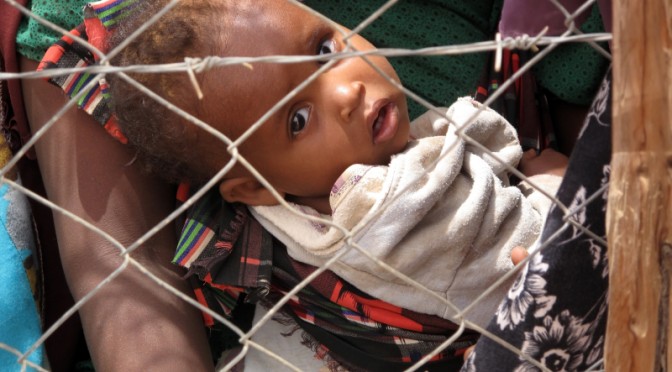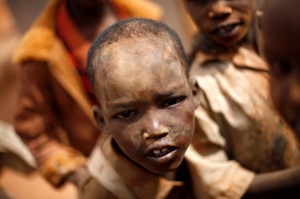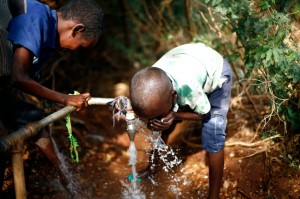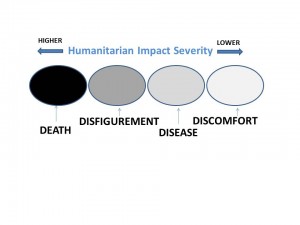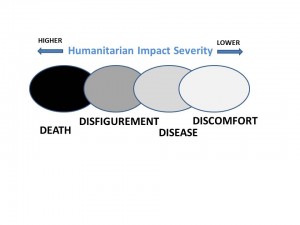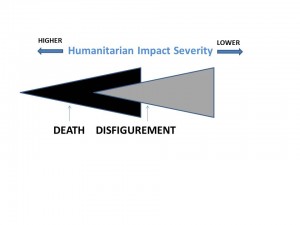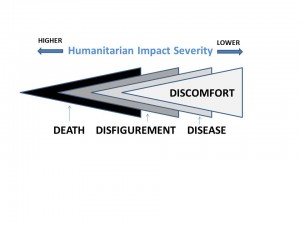We promote 3 steps to help overcome more poverty sooner, with the same or less resources. Define poverty, map poverty and focus the fixers. Central to poverty mapping, is an effective system of poverty measurement. Finding a consistent, underlying approach to measurement across all 7 Layers of the Poverty Model was daunting indeed. To be honest, we weren’t even sure it was possible, let alone advisable. So we took an intellectual step back, realising that underlying our collective efforts to overcome poverty, was a single, integrating factor: enlightened humanitarian concern. What we came up with is something we call “The Humanitarian Impact Spectrum”. It is our best efforts at developing an integrated conceptual model for the ‘otherwise-virtually-incomparable’. We kid you not.
There is a widely adopted expression, used to describe the highest guiding principle of all moral choice and action, including such things as our own humanitarian concern. It is expressed in the question: What result generates “the greatest good for the greatest number?” This thinking was originally articulated by Jeremy Bentham and others, in a philosophical framework called “utilitarianism”. Greater minds than ours have pondered the many dimensions to this question. It seems self-evident genius, until one asks the pertinent question: How exactly does one measure the relative “good” of widely different intended outcomes, particularly when those outcomes are themselves uncertain?
It might at first seem simple enough, if all human beings are created equal, to say that an action that benefits 100 people outweighs a comparable action that benefits one. But there are some real world flaws. All people are not in fact “equal”.
Consider a simple scenario, which may even be making news in your own country, if your healthcare system supports modern organ transplants. You have one good donor liver and 2 possible patients who both need it to live. Who gets it? Instinctively you know to ask more questions, realising that both cases cannot be exactly equal and one must have more MERIT than the other. So let’s make it easier for you. One is a teenage university medical student, who was tragically injured, whilst trying to rescue children from a school bus accident. The other is an ageing convict, at the end of his expected years, whose body is suffering from decades of alcoholism and drug abuse and currently doing 20 years in prison for a gang-related murder. All men may be created equal, but it seems they do not stay that way – at least, so it would appear, when it is left to our moral conscience as to who gets the only available liver – right?
The liver is an example. It is just one instance of a finite resource. You can imagine many others. You might also make the connection between the illustrative need for a donor liver and the very real need for the 7 Humanitarian Basics, for literally billions of people worldwide. All of a sudden the choice of liver patient looks pretty easy by comparison, right? Well, don’t panic just yet. We have an idea that we think will help crystallize your thinking a little. But first, we have to make things worse, before we help them get better. Sorry.
You see there is another entire side to the moral spectrum. Yes, really. It is not enough to consider real life choices from among a theoretical range of “goods”, even if you COULD figure out which one of them was in fact the greatest. No. In real life, we must also allow for a range of BADS. If we can imagine a spectrum going from morally neutral, all the way to the ‘greatest good’, then we must similarly allow for that same continuum to extend all the way to the ‘greatest bad’. So, we now have a complete theoretical SPECTRUM, running from the greatest bad at one extreme, through morally neutral, all the way to the greatest good at the other end. Agreed? Fairly simple to imagine in principle; very hard to work out in practice. But practice is where it really counts, so try we must. So let’s press on…
Underlying all that potential difficulty – and in fact mankind’s moral conundrums on the whole – is the thorny issue of effective COMPARISON. We may feel able to make moral comparisons – and hence moral choices – between scenarios which have certain clear similarities. Should we choose an outcome that gives a unit of benefit to 1 person, or 100 people? Or, for an individual, should we choose an outcome that delivers a small benefit, or a great one? In both cases, all other things being equal, we choose the latter, ‘greater’ option. The issue in real life, is that things are not that SIMPLE, because things are not that EQUAL.
So how can we come up with some kind of conceptual model, for making sense of the complex, real-world, moral choices we face, when considering 7 dimensions of poverty for several billion people? Well, we’re glad you asked. The answer, in our view, is to first reflect on what constitutes being ‘humane’, in treating another person as we would like to be treated ourselves. In particular, when it comes to poverty, we collectively tend to be focused more on the avoidance, or removal of existing poverty ‘bads’, as our best guide to achieving “the greatest good” in overcoming poverty overall.
Simply put, our immediate priority is channelling limited resources into addressing the relative absence of the Humanitarian Basics for affected individuals. This is rather than devoting those same finite resources to the creation, or establishment of other greater “goods” on an individual’s behalf, that go beyond the immediate poverty eradication remit. Put another way, our focus is more to help motivated individuals escape ‘bads’ of extreme poverty, rather than taking those same individuals all the way through to the ‘good’ of becoming “rich”. Just richer than they were – rich enough to escape extreme poverty.
This is because we recognise that human resources, including time, are limited and we anticipate certain diminishing returns on invested efforts. We therefore want to maintain priority focus on overcoming the greatest poverty ‘bads’ for the greatest number, sooner. Others may wish to take a different approach and are clearly free to do so. Let’s take a moment to examine the reasoning that our approach is firmly based on.
OK, we recognise that many might find this controversial, but we would rather come up with something potentially useful, than attempt nothing at all. We would rather offer something practical and illustrative, in the absence of anything universal and definitive. So, in a nod towards the hit American TV series of the same name, we’ve set about “Breaking Bad” into 4 distinct, but overlapping categories of human woe. They all begin with D – just to help you remember them. How considerate of us, right? You can think of them as the 4 Horsemen of the Humanitarian Apocalypse…
DEATH
All 4 categories of ‘bad’ are relatively ‘ranked’ in terms of perceived SEVERITY of their humanitarian impact. Let’s start with the worst impact first. Death. Of the permanent, no-coming-back variety. We absolutely recognise the concept and possibility of there being “a fate worse than death”. The very acts of suicide and ‘assisted dying’ reflect that for some, there are indeed worse things to face than death itself. However, on the moral (and hence usually legal) spectrum, cultures around the world typically recognise death as the worst category of impact you can usually inflict upon another human being.
There may be degrees of ‘bad’ associated with the causing of such a death, usually revolving around the perpetrator’s intent and various possible mitigating circumstances. In Western cultures and legal systems, at least, one can be legally held responsible for deaths caused by neglect and INACTION, as well as deliberate action. For example, parents can be held legally liable for the death of their child, if they are found not to have given them adequate care and supervision. Death as a category of impacts, then, sits at the worst and furthest extreme of our Humanitarian Impact Spectrum.
DISFIGUREMENT
The next most severe ‘bad’ category, is one we have labelled DISFIGUREMENT. The point here is that it is not generally considered as ‘severe’ as death in humanitarian terms, but it shares the same notion of a permanent and severe ‘bad’. It involves a lasting, negative change to the individual’s normal bodily form and function (limbs, organs, faculties, or appearance). Typically, outcomes in this category would be deemed ‘irreversible’ without specialist surgical intervention (transplants, artificial aids, etc).
Whilst we readily recognise the idea of different degrees of disfigurement, this can still be heavily influenced by the person’s culture and personal preferences. Most people and cultures will consider the loss of sight as a major ‘disfigurement’ by our definition, while the loss of a toe, or a sense of smell may be less significant in terms of quality of life impact. But ‘impact’ will always necessarily remain subjective, to a degree. The causes of such disfigurement can be manifold, frequently including factors originating in our next category of ‘bads’.
DISEASE
This is the category we have labelled DISEASE. Disease is clearly closely linked with the ‘bads’ either side of it (Disfigurement and Discomfort). The distinguishing characteristic here is one of an outcome’s PERSISTNECE, rather than permanence. It relates to impairment of form and/or function, but need not mean permanent – just as long as the disease condition persists in the individual.
It involves direct harm, or dysfunction to the individual’s normal bodily function and condition. The disease may indeed be curable, but if it is not in fact cured in the case of the individual concerned, then it has the same net effect as Disfigurement, in terms of the relative impact on human life. Note also, that there is often an extra dimension to Disease – that of potential numerical impact. Diseases can and do SPREAD. If a person loses a limb through a farming accident, it is tragic, but not contagious. Certain diseases can equally cause the loss of limbs, but they can be considered a greater ‘bad’ in terms of the number of people they MIGHT infect as an outcome, as well as those that they actually HAVE affected already.
DISCOMFORT
The last of our 4 D’s is DISCOMFORT. This is deliberately meant as a broad and inclusive term. It can be taken as covering unpleasantness to any of the human senses. There can be discomfort associated with smell and taste (eg with water quality), as well as chronic and severe physical pain. All register somewhere in our broad scale and category of Discomfort. It is down to common experience and subjective assessments, as to how minor, major, or extreme an individual’s discomfort level might be, when assessing ‘bad’ humanitarian outcomes.
Straight away, we imagine you may be coming up with your own overlapping scenarios. What about the person suffering from such severe pain, that they feel they would rather take their life, than face another day of it? Or what about the psychological discomfort of not feeling safe in your own community, but without any actual physical harm done? This relates more to potential threat, than measurable sensation. These are valid points and we have tried to allow for them in the Simple Assessment questions and grading system we advocate elsewhere. We acknowledge it is a broad category, but its breadth helps complete the proposed 4 category divisions. Some may wish to suggest alternative bases of distinction between the various types of ‘bad’, even while recognising that there is often overlap and blurred lines between categories in the real world.
One way of expressing the overlap, is rather like a Venn diagram. However, since each category contains examples that might be deemed as serious as instances of scenarios in higher categories, perhaps this is better expressed as overlapping triangles, extending up inside other triangles, generally considered as more severe categories on the spectrum.
Thus, there are few instances where discomfort is considered SO extreme that it qualifies in some minds as morally, or ‘outcome-equivalent’ to death. Conceptually at least, we will allow for it. Similarly, we have made this allowance with disease and disfigurement. There are some outcome instances within these categories, that some might consider “as bad as” death itself, potentially driven by certain associated cultural factors. Similarly, one can imagine scenarios where one might consider a permanent disfigurement, as better than a disease, or ongoing discomfort of a certain level. Gangrene and other conditions that lead to chosen limb amputations, are an example.
In the absence of a better, or more useful common scale, each of the 4 ‘bads’ could be further split into notional (but necessarily subjective) extreme, high, medium and low severities. Extreme is added as a category to account for the notional extension into a couple of categories above, or more. Hence ‘extreme’ in the Discomfort category, would include scenarios where the pain felt was so severe, that the individual might consider it on a par with Death, or Disfigurement alternatives. The aim here is not to be definitive, or prescriptive, but to help create a common language and terminology, that permits a basis for sensible discussions, comparisons – and indeed hard choices – between otherwise seemingly incomparable alternatives.
These distinctions have influenced the 21 questions of the Simple Assessment. The numbering system it uses, broadly reflects the high/medium/low/none options, where ‘none’ correlates to extreme, or severe conditions, typically reflecting crisis conditions in the given dimension of poverty, for the individual concerned. Thus, qualitative notions of high, medium, low and none can be translated into quantitative, numerical data, which makes for easier aggregation and subsequent statistical analysis. In particular, when it comes to mapping poverty, the thinking behind the measurements will have some frame of reference in common human experiences, rather than being some isolated, unfeeling digit, or a purely academic measurement exercise.
We have given you the Humanitarian Impact Spectrum model, to help unpack the utilitarian principle: What decisions will lead to the greatest good for the greatest number? We recognise the ideas of overlap, degree, blurred lines and subjectivity, yet still feel the model is flexible enough to accommodate these, without losing the usefulness of its basic shape and structure. You are free to disagree. The real test comes in the real world. If you find it works – great. Keep it and use it with our blessing. If not – ditch it and look for (or invent) something better!
Until then, we thank you for being…One in a Billion

